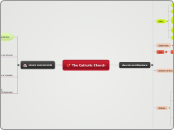The Catholic Church
church architecture
ambo
part of sanctuary
Announcing Bible readings as Word of God
Altar
place of sacrifice of Christ
central part of sanctuary
Priest consecrates bread
and wine to become
Body and Blood of Christ
After mass communion
place in Tabernacle
outside mass bow to altar when there is
no tabernacle
celebrate eucharist
Tabernacle
used to store holy communion
genuflect towards it
used for private and public worship
font
used for baptism
washes away all sin
makes us Christians, members of God's family
and members of the Church
one baptism for all
at the front of the church to show link
with eucharist
stations of the Cross
shows sacrifice of
Our Lord
in pictures for those who cannot read
used particularly during Lent
private and public prayers
statues
used to honour those who have
followed Our Lord
reminder to Christians that
we can follow Christ well
those who have died are also part
of the Church
Catholics do not worship statues,
ONLY GOD
Mary, Mother of God, the most common statue
she is worthy of honour, not worship
she was conceived without stain of sin, known as
IMMACULATE CONCEPTION
in Catholic tradition, remained a virgin
gave birth to Son of God,
called Mother of God
some major feast days
annunciation, 25th march
Angel Gabriel tells Mary she will conceive and
bear the Son of God
Subtopic
Christmas
Immaculate Conception,
8th December
Assumption, 5th August
at the moment of death,
Our Lady taken, body and soul,
to heaven.
feast shared with Orthodox Christians,
who call it the Dormition
decoration and furnishings
for
helps to focus mind
God becomes man, therefore not breaking
the first Commandment
long standing tradition in apostolic Churches
reminder of what we can become
reminder of living and dead
God created beauty
against
breaks commandment
can be a distraction
fear of seeming idolatry
seven sacraments
definition
sacraments of iniation, bringing fully into the Church
baptism
baptism is a sacrament which washes
away Original Sin, makes us Christians,
members of God's family and members of the Church
symbols of baptism
water
cleanses
gives life
refreshes
oil
catechumens
prepares for baptism
chrism
used to anoint those asked by God to
complete a task in life
king David and Our Lord both anointed with oil
used to anoint prophets, priests and kings
a mixture of olive oil and balsam
olive oil used as medicine and fuel
candle
Christ as the light of the world
Christians called to let light of
Christ shine in their lives
the light spreads, as does the faith
gives direction in times of darkness
white garment
shows purity of soul
no stain of sin
necessary for salvation
Go therefore to all nations
and baptize them
in the name of the Father, and of the Son,
and of the Holy Spirit....
The only way we know of by which we can be saved.
(catechism of the Catholic Church)
baptism of Our Lord in the River Jordan
by John the Baptist.
arguments for and against
infant baptism
for
Cornelius and all his household, in Acts, were baptized, including children
tradition of all apostolic Churches
brought up from childhood to follow Christ
grow in love of Christ
join the family of God and the Church
make own commitment later, in confirmation
jews circumcised at 8 days to bring them into Jewish faith
against
baptism should be a personal choice, not forced
no personal commitment
can come to know Christ without baptism
Jesus baptised as adult
confirmation
Pentecost- the coming of the Holy Spirit.
Promised by Christ
disciples hiding in upper room
afraid they would be arrested
for being followers of Jesus
Holy Spirit came in form
of tongues of flame
received courage to preach about Christ
word means strengthening
person chooses confirmation
renews baptismal promises
becomes an adult, a
soldier, in the faith
symbols
laying on of hands
ancient symbol
used in the Bible
passing on the Spirit
anointing with oil
ancient symbol - chosen for a task
oil strengthens
oil of chrism
ordinary minister is the bishop
eucharist
sacraments of vocation
marriage
union of one man and one woman
a permanent union until death
"what God has joined together,
man must not separate
no divorce and then remarriage
in Catholic Church
annulment recognises that sacramental
marriage did not take place.
reflection of God's love
which is for ever
2 purposes of marriage
procreative
life giving
open to having children
no contraception
unitative
2 become 1
remain always faithful
no sexual conduct
outside the marriage
no sex before marriage
no adultery
(6th commandment)
holy orders
origin
ranks
married clergy
female clergy
sacraments of
reconciliation/forgiveness
confession/reconciliation
sacrament of the sick
